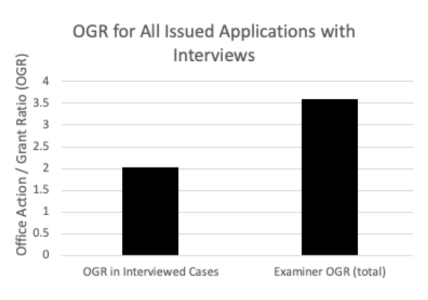Supercharge Patent Prosecution With Examiner Interviews
What You Need to Know
Key takeaway #1
Examiner interviews may help minimize the time and costs associated with patent prosecution and expedite allowance.
Client Alert | 17 min read | 07.24.24
Examiner interviews are an optional but important and effective part of patent examination process that are beneficially conducted early and, in some cases, more than once during patent prosecution. Interviews are in-person, telephone or online conferences between the Examiner and the patent attorney or patent agent representing the patent applicant. When conducted early in the patent examination process, interviews may reduce the time required to obtain a patent and increase the odds of obtaining an allowance. As discussed below, interviews can help foster a cooperative interaction with the examiner to supercharge the prosecution process.
The Patent Examination Process – A Brief Overview:
Obtaining a patent requires persuading a patent examiner that an invention is sufficiently different from the state of the art, also known as the prior art. This activity by the patent attorney or patent agent is commonly referred to as patent prosecution. The interaction between the examiner and the attorney or agent representing the patent Applicant is primarily through written documents. After reviewing a patent application, in more than 90% of the cases, an examiner issues a first office action in writing that rejects the application and explains how the claimed invention is not patentable over the prior art. The patent attorney/agent typically responds by filing a paper with arguments defending the patentability of the claimed invention and/or amendments narrowing the scope of the claims to avoid overlap with the prior art. In response, the examiner may agree to allow the claims or continue to reject the application, giving the attorney/agent another opportunity to respond. The exchange may go back and forth multiple times until the patent application is allowed, the application is abandoned, or the applicant chooses to appeal the rejections.
Examiner interviews are an option that can be used early and sometimes often during the examination process. An interview may be conducted after receipt of an office action but prior to submission of a written reply by the attorney/agent. Normally, 30 minutes are allotted for the interview, which may take the form of a teleconference, online/video conference or in-person meeting with the examiner. The examiner may ask the patent attorney/agent to submit a written agenda prior to the interview. During the interview, the attorney/agent has an opportunity to openly discuss the status of the case, better understand the examiner’s position, and educate the examiner about the invention and why it is patentable. No transcript or recording of the Interview is made, but a brief one paragraph summary of the Interview is made by the examiner and the applicant’s attorney/agent, which become part of the record. For more information about interviews, please see MPEP 713.
Why interview?
First and foremost, the goal is to minimize the time and costs associated with patent prosecution and expedite allowance. Interviews provide an opportunity to make a personal connection with the examiner and to ensure that he or she has the correct understanding of the invention and the prior art, both of which may be essential to fast track prosecution. In addition, interviews may allow the attorney/agent to highlight distinctive patent-worthy features of the invention and negotiate with the examiner about the scope of possible amendments. A patent application is examined under the “Broadest Reasonable Interpretation” (BRI) standard, which means that the examiner may use an interpretation of a term defining the invention that is broader than the scope intended by the inventor, such that the invention under this broad interpretation covers the prior art. Interviews can help bring the examiner and the attorney/agent into alignment on the meaning of terms or to bring clarity to the scope of the invention. Likewise, interviews can bring the parties together on what the prior art describes and how it is similar or different from the invention. Interviews may also give the attorney/agent an opportunity to test out arguments with the examiner that can be refined or improved after feedback during the interview.
But with the prep and interview time, don’t interviews add cost?
Not in the long run. There may be additional up-front time to prepare the agenda and speak with the examiner. However, the preparation time reviewing the office action and prior art is required anyway for developing a written response, and the interview may result in streamlining writing the response, particularly if agreement is reached with the examiner. In such a situation, the response may refer back to the interview and provide only the briefest necessary comments, rather than providing a lengthy argument. Besides reducing attorney/agent time, brief responses are advantageous when litigation is of concern and it is imperative to minimize the written record. Furthermore, getting on the same page with the examiner early in the examination process may reduce the number of office actions and increase the likelihood of allowance. The chart below shows a significant reduction in the number of office actions in cases where an interview was conducted compared with cases where no interview was conducted – 2.0 vs. 3.5 office actions.

Source: S. Sean Tu, W. Virginia Univ. College of Law
Is an interview always beneficial?
In general, examiner interviews are useful: (1) to establish a rapport and build trust with the examiner; (2) to enable a nuanced discussion of the claims in view of the teachings of the prior art; and (3) to interactively discuss proposed claim amendments. In addition, interviewing may help applicants explore an examiner’s deep knowledge of the prior art when making claim amendments to potentially strengthen the enforceability of any resulting patent.
In our experience, interviewing is beneficial early in the examination process. It is most helpful in these situations: (1) when the rejections reveal a misunderstanding of the claimed invention; (2) when the applicant and the examiner disagree on the teachings of the prior art; or (3) when the prior art uncovered by the examiner’s search warrants an amendment to advance prosecution. In the first two cases, the interview provides an opportunity to explain the technology and better understand the examiner’s perspective to ensure that allowance is not delayed by technical misunderstandings. In the third case, the attorney/agent may negotiate about the language required for an amendment and get the examiner’s input to ensure that a proposed amendment is deemed sufficient to overcome the rejection.
Conversely, an interview may not be needed in situations where a simple, written reply will likely result in the allowance of the claims.
Should the inventors be involved?
Inventors always have the option of participating in an examiner interview; however, their presence during an interview should be used selectively. For example, given their scientific or professional credentials, inventors may effectively engage in nuanced discussions with examiners on the technology at issue and their assessment of the prior art may carry more weight than an attorney’s or agent’s. In some situations, inventors may have a compelling backstory to tell based on their personal experience in developing the invention, e.g., challenges that had to be overcome, unexpected results, or the significance of the invention. In addition, the fact of their presence during the interview may implicitly convey to the examiner the importance to the applicant of having a patent issue on the invention. The role of an attorney/agent in these situations is to help guide the discussion, to create bridges between the inventor and examiner, and to help frame the discussion to address the applicable legal standards of the rejections.
Even if inventors are not present during the interview, inventor input regarding the technology and the commercial applications to be protected by the patent can nevertheless be helpful during attorney/agent’s preparation for the interview. Thus, although it is not necessary for inventors to be present during an examiner interview, inventors may provide valuable input as part of the attorney/agent’s preparation for the interview.
What outcomes are possible?
Ideally, agreement is reached and the examiner states on the record that the current rejections will be withdrawn upon submission of the written reply. In rare cases, the examiner may be persuaded that the office action is so flawed that he or she agrees to withdraw the office action without a reply being filed. Unless the examiner identifies new prior art in a further search, a notice of allowance may be issued.
Even if agreement with the examiner is not reached, the interview may be productive. For example, the examiner may provide input that allows the patent attorney/agent to adjust the amendment strategy prior to submitting the response, streamlining prosecution and better positioning the case for allowance. Also, the interview may give the attorney/agent a better feel for which arguments may be more persuasive than others.
In short, we believe the above guidelines are good starting points for developing an interview strategy that may reduce the number of office action and expedite allowance. Regardless, you should seek advice of the attorney/agent handling your specific patent application.
*The comments expressed above are those of the authors and are for educational purposes only, and should not be construed as legal advice for your particular patent application.
Contacts
Insights
Client Alert | 10 min read | 12.24.25
Since the signing of Executive Order 14187 (“Protecting Children from Chemical & Surgical Mutilation”) in late January 2025, the Trump Administration has made its skeptical stance on gender-affirming care—especially regarding services provided to minors—clear.
Client Alert | 3 min read | 12.24.25
Keeping it Real: FTC Targets Fake Reviews in First Consumer Review Rule
Client Alert | 5 min read | 12.23.25
An ITAR-ly Critical Reminder of Cybersecurity Requirements: DOJ Settles with Swiss Automation, Inc.
Client Alert | 2 min read | 12.23.25
Record-Setting False Claims Act Settlement Highlights DOJ Commitment to Customs Enforcement





